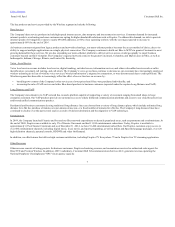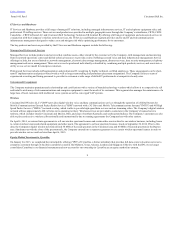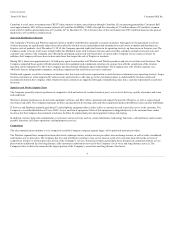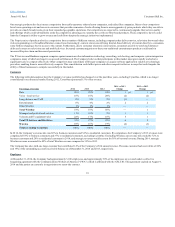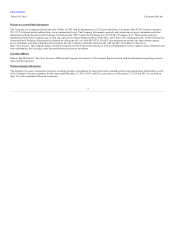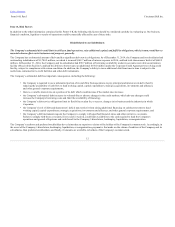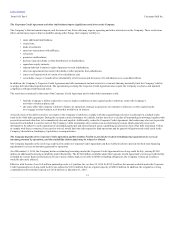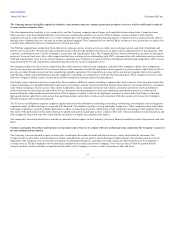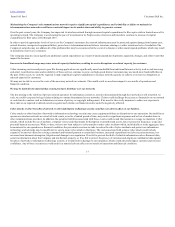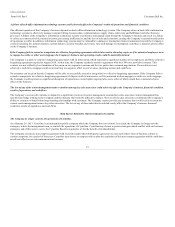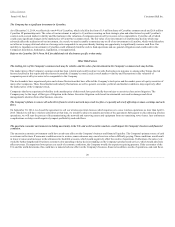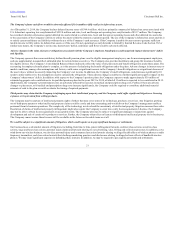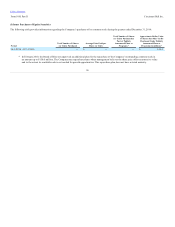Cincinnati Bell 2014 Annual Report Download - page 17
Download and view the complete annual report
Please find page 17 of the 2014 Cincinnati Bell annual report below. You can navigate through the pages in the report by either clicking on the pages listed below, or by using the keyword search tool below to find specific information within the annual report.
Table of Contents
Form 10-K Part I
Cincinnati Bell Inc.
Maintaining the Company's telecommunications networks requires significant capital expenditures, and its inability or failure to maintain its
telecommunications networks would have a material impact on its market share and ability to generate revenue.
Over the past several years, the Company has improved its wireline network through increased capital expenditures for fiber optic cable in limited areas of its
operating network. The Company is accelerating the pace of investment in its Fioptics suite of services and intends to continue to increase its capital
expenditures for fiber optic cable through 2016.
In order to provide appropriate levels of service to the Company's customers, the network infrastructure must be protected against damage from human error,
natural disasters, unexpected equipment failure, power loss or telecommunications failures, terrorism, sabotage, or other intentional acts of vandalism. The
Company's networks may not address all of the problems that may be encountered in the event of a disaster or other unanticipated problems, which may result
in disruption of service to customers.
The Company may also incur significant additional capital expenditures as a result of unanticipated developments, regulatory changes, and other events that
impact the business.
Increases in broadband usage may cause network capacity limitations, resulting in service disruptions or reduced capacity for customers.
Video streaming services and peer-to-peer file sharing applications use significantly more bandwidth than traditional Internet activity such as web browsing
and email. As utilization rates and availability of these services continue to grow, our high-speed Internet customers may use much more bandwidth than in
the past. If this occurs, we could be required to make significant capital expenditures to increase network capacity in order to avoid service disruptions or
reduced capacity for customers.
We may not be able to recover the costs of the necessary network investments. This would result in an adverse impact to our results of operations and
financial condition.
We may be liable for the material that content providers distribute over our networks.
The law relating to the liability of private network operators for information carried on, stored or disseminated through their networks is still unsettled. As
such, we could be exposed to legal claims relating to content disseminated on our networks. Claims could challenge the accuracy of materials on our network
or could involve matters such as defamation, invasion of privacy or copyright infringement. If we need to take costly measures to reduce our exposure to
these risks or are required to defend ourselves against such claims, our financial results would be negatively affected.
Cyber attacks or other breaches of network or other information technology security could have an adverse effect on our business.
Cyber attacks or other breaches of network or information technology security may cause equipment failures or disruptions to our operations. Our inability to
operate our wireline networks as a result of such events, even for a limited period of time, may result in significant expenses and/or loss of market share to
other communications providers. In addition, the potential liabilities associated with these events could exceed the insurance coverage we maintain. Cyber
attacks, which include the use of malware, computer viruses and other means for disruption or unauthorized access, have increased in frequency, scope and
potential harm in recent years. While, to date, we have not been subject to cyber attacks or other cyber incidents which, individually or in the aggregate, have
been material to our operations or financial condition, the preventative actions we take to reduce the risk of cyber incidents and protect our information
technology and networks may be insufficient to repel a major cyber attack in the future. The costs associated with a major cyber attack could include
expensive incentives offered to existing customers and business partners to retain their business, increased expenditures on cyber security measures, lost
revenues from business interruption, litigation and damage to our reputation. If we fail to prevent the theft of valuable information such as financial data,
sensitive information about the Company and intellectual property, or if we fail to protect the privacy of customer and employee confidential data against
breaches of network or information technology security, it would result in damage to our reputation, which could adversely impact customer and investor
confidence. Any of these occurrences could result in a material adverse effect on our results of operations and financial condition.
17


